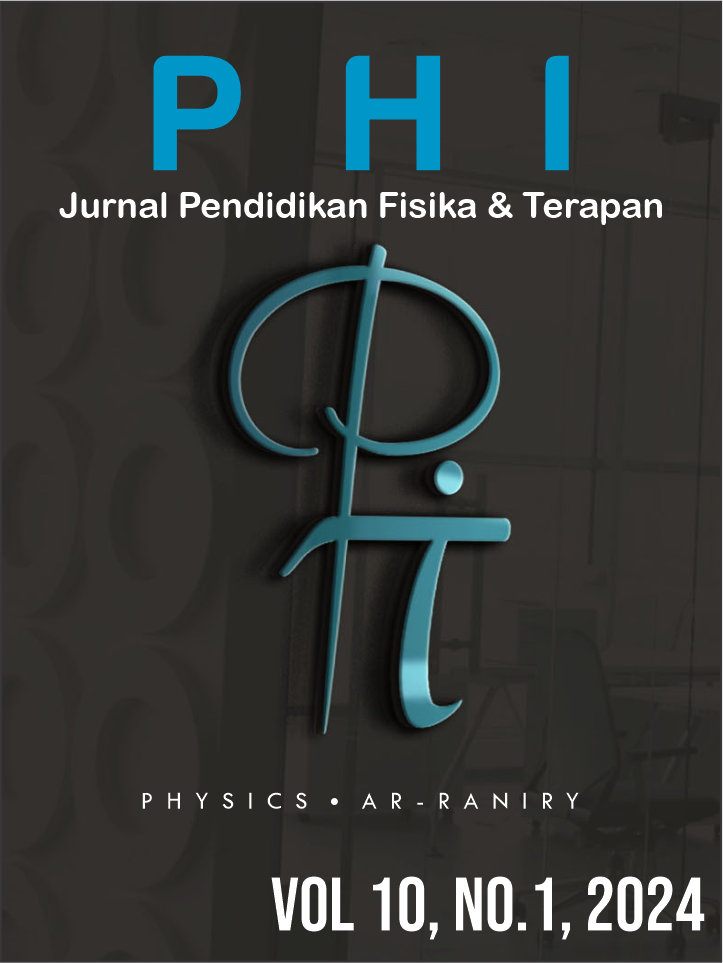Identification Of Soil Resistivity Distribution In Ekoriparian Leuwi Padjadjaran Area Using 2D Electrical Resistivity Method
DOI:
https://doi.org/10.22373/p-jpft.v10i1.22401Keywords:
soil, resistivity, Res2DinvAbstract
Research focused on the identification of soil resistivity distribution at the Ekoriparian Leuwi Padjadjaran area, University of Padjadjaran, Jatinangor, has been conducted using geoelectric resistivity method 2D with dipole - dipole configuration. Three survey lines were measured with the first and second lines being 2 meters long and the third line measuring 6 meters. Electrode spacing was set at 0.2 meters, with 10 electrodes on the first and second lines, and 30 electrodes on the third line. Data processing is done using the Res2Dinv software. The research results indicated that resistivity values in the range of 4.00 Ωm to 20.0 Ωm were interpreted as clay rocks, values from 20 Ωm to 200 Ωm were interpreted as silt rocks, and resistivity values in the range of 256 Ωm to 1024 Ωm were interpreted as sandy clay rocks. Based on the geology of the study area, the soil is a fine-grained soil, namely silt and sandy loam.
References
Afif, N.N.H. (2016), Hubungan Mineral Lempung dengan Koefisien Konsolidasi Tanah di Kawasan Kecamatan Jatinangor, Kabupaten Sumedang, provinsi Jawa Barat Universitas Padjadjaran,.
Alwan, I.A.K., (2013). Comparison Between Conventional Arrays in 2D Electrical Resistivity Imaging Technique for Shallow Subsurface Structure Detection of the University of Technology, Eng.&Tech.
Journal, Vol.31, Part (A). No. 10, 2013, p.1817 – 1824.
Djadja., Hermawan. (1996), Peta Geologi Teknik Lembar Bandung skala 1:100.000, Direktorat Geologi Tata Lingkungan, Bandung.
Farahnaz, N., Sophian, R.I., Mulyo, A., Hendarmawan. (2018), "Potensi tanah Mengembang Hasil Lapukan Batuan Vulkanik Berdasarkan Indeks Plastisitas di Kawasan Desa Cilayung”, Geoscience Journal, Vol.2, No.1, hal. 82–89.
Hamidah, A. M. (2016). Estimasi 3-D Kedalaman Batuan Dasar Menggunakan Data Geolistrik Tahanan Jenis Konfigurasi Dipole-Dipole. 8, 97–104.
Irianto, A.I., Rahmawati, E. (2014), "Prototipe Alat Ukur Resistivitas Tanah Dengan Metode FourPoint Probes", Prosiding Pertemuan Ilmiah XXVIII HFI, Diambil dari https://www.academia.edu/27634921/Prototipe_Alat_Ukur_Resistivitas_Tanah_dengan_Meto de_Four_Point_Probes.
Kirsch, R. (2006), Groundwater Geophysics a Tool for hydrogeology, Verlag Berlin Heidelberg, Germany.
Loke, M.H. (1999), Electrical imaging surveys for environmental and engineering studies, Edgbaston, The University of Birmingham
Loke, M. H. (2010). Tutorial : 2-D and 3-D Electrical Imaging Surveys. From www.geolectrical.com
Lowrie, W. (2007), Fundamentals of Geophysics, Second Edition, Cambridge University Press, New York
Muhardi., Wahyudi. (2019), ‘Identifikasi Litologi Area Rawan Longsor di Desa ClaparBanjarnegara Menggunakan Metode Geolistrik Resistivitas Konfigurasi Schlumberger’, Jurnal Fisika, vol. 9, no. 2, pp. 52–59
N. Khoirulla. (2016), Hubungan Ukuran Butir Tanah, Mineral Lempung, dan Kemiringan Lereng Dengan Nilai Erodibilitas pada Tanah Lapukan Batuan Vulkanik Muda Jatinangor, Universitas Padjadjaran.
Nurfalaq, A., Jumardi, A. (2019), ‘Identifikasi Batuan Bawah Permukaan Daerah Longsor Kelurahan Kambo Kota Palopo Menggunakan Metode Geolistrik Konfigurasi Dipole-Dipole’, Jurnal Geocelebes, vol. 3, no. 2, pp. 66–74.
Pratama, W., Rustadi, dan Haerudin, N. (2019), ‘Aplikasi Metode Geolistrik Resistivitas Konfigurasi Wenner- Schlumberger Untuk Mengidentifikasi Provinsi Lampung’, Jurnal Geofisika Eksplorasi, vol . 5, no. 1, pp. 30–44.
Rozaq, A. (2004), Identifikasi Kedalaman dan Struktur Lapisan Bawah Tanah Candi Jajaghu Berdasarkan Nilai Resistivitas Dengan Menggunakan Metode Geolistrik Konfigurasi Dipole-Dipole. Universitas Brawijaya, 1, 1–5.
Rukmana, Y. Y., Zakaria, Z., Muslim, D., & Seraphine, N. (2020), Korosifitas Pada Tanah Lapukan Vulkanik Berdasarkan Nilai Tahanan Jenis Tanah Di Kawasan Unpad Jatinangor, Kabupaten Sumedang, Jawa Barat. Jurnal Geosaintek, 6(2), 77. https://doi.org/10.12962/j25023659.v6i2.6581
Rustadi, Pauzi, G. A. dan Taufik, O. (2018), ‘Investigasi Geologi dan Geolistrik Untuk Menafsirkan Keberadaan Air Tanah Dangkal di Ambarawa, Lampung’, Jurnal Teori dan Aplikasi Fisika, vol. 06, no. 01, pp. 109–114.
Septyanto, B., Nafian, M., Dwiningsih, N. I. (2019), Identifikasi Lapisan Batuan Di Daerah Bojongsari, Depok Menggunakan Metode Geolistrik Resistivitas. Al-Fiziya: Journal of Materials Science, Geophysics, Instrumentation and Theoretical Physics, 1(2), 7–14. https://doi.org/10.15408/fiziya.v1i2.9503
Silitonga, P.H. (2003), Peta geologi lembar Bandung, Jawa. Diambil 31 Agustus 2020, dari https://opac.perpusnas.go.id/DetailOpac.aspx?i d=719712.
Telford, W.M., Geldart, L.P., and Sheriff, R. E. (1990), Applied Geophysics Second Edition, 2nd edn, Cambridge University Press, New York.
Wahyudi, A., Azwar, A., & Muhardi, M. (2021), Penggunaan Metode Geolistrik Resistivitas untuk Identifikasi Lapisan Bawah Permukaan Gunung Tujuh Kabupaten Kayong Utara. Jurnal Fisika Unand, 10(1), 62–69. https://doi.org/10.25077/jfu.10.1.62-69.2021
Downloads
Published
Issue
Section
License
Authors who publish with Jurnal Phi agree to the following terms:
- Authors retain copyright and grant the journal right of first publication with the work simultaneously licensed under a Creative Commons Attribution License (CC BY 4.0) that allows others to share the work with an acknowledgment of the work's authorship and initial publication in this journal.
- Authors are able to enter into separate, additional contractual arrangements for the non-exclusive distribution of the journal's published version of the work (e.g., post it to an institutional repository or publish it in a book), with an acknowledgment of its initial publication in this journal.
- Authors are permitted and encouraged to post their work online (e.g., in institutional repositories or on their website) prior to and during the submission process, as it can lead to productive exchanges, as well as earlier and greater citation of published work (See The Effect of Open Access).

















